|
|
|
 |
The Memotech MTX Series |
 |
The Memotech HRX
Multimedia PC
Overview
| Memotech developed a high
resolution graphics package based on the MTX and FDX, called the
HRX which was developed for picture and image
processing.
The features of HRX are described in the
MTX Series
Technical Specification . . . .
"The basic monochrome system uses a single
"colour" plane and gives 4 pages of 256x256x8 bit
storage giving 256 levels of grey per pixel. The
colour system used three colour planes (R, G and
B) giving 224 or 16 million colours
per pixel. This is more than that required for
colour TV (250,000 colour shades) and the extra
storage capacity can be used for picture
processing."
These specifications are likely
pre-production, the hardware schematics show
that the analogue to digital convertors had 6,
rather than 8, bit resolution, giving 218
or 256 thousand colours per pixel. This was
likely done to reduce the cost of the A/D
convertors and associated RAM.
The system was designed to allow direct TV or
video camera input into its frame store, the HRX
had a set of analogue to digital converters
which worked at video speed and fast interleaved
DMA storage which allowed data to be written to
the system at video frame rate (88M bit/s). This
allowed the system to grab video frames in real
time and perform real time image enhancement and
processing.
In addition to the real time processing
capability, a software package running on an MTX
computer could perform fast, off-line processing
of pictures stored in the HRX frame memory,
including, in addition to basic dot and vector
line drawing capabilities, such functions as
zoom, shrink, rotate, etc.
Memotech envisaged that applications for the
HRX included graphics design, image enhancement,
animation etc. However, whilst the system was
certainly technically advanced for its time, it
is unlikely that it was commercially successful.
The HRX system gets a brief mention in the
The Home Computer Advanced Course
article on the
Memotech company :-
"Starting with an unexpanded MTX500, the user
can add disk drives and the three graphics
controller boards: a 96-bit processor main
controller board, a 'Frame Grabber' and a three
channel A/D converter. The resulting system is
able to produce animations, picture composition
and graphic design up to a full typesetting
capacity. The system costs around £4,500."
The HRX system is also mentioned in an
article about Video Processing from the November
1984 edition of
Computers & Electronics Magazine. |
| The HRX was also reviewed by
John J. Anderson, the writer for Creative
Computing, who reviewed the MTX in the June 1984
issue of the magazine, complete with an HRX
image capture of himself! Despite not being
able to locate this article for a long time, I
have just managed to find a copy at
archive.org and posted
it on the
Articles page. |
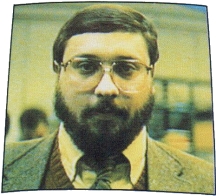 |
Sandwiched between the pages of the MTX512 review, is
a half page devoted to the HRX. Anderson says "There in
front of me was the most incredible video frame grabber
I had ever seen."......"There have been hi-res frame
grabbers before, and there will be more in the future.
But the Memotech hi-res image processor represents a
breakthrough in performance for the price. Sure, it's
pricey - about $14,000 at the current rate of exchange
for the pound sterling. But capability of this quality
cost three times as much before Memotech came on the
scene."
Andy Key recalls that the HRX contained a high
resolution graphics card (at 256x256x18bpp) and had
basic image processing, such as sharpen, blur, scale,
rotate, etc. and was shown at trade shows, but he is not
sure any were ever sold.
Andy also has some copies of screen captures showing
the three famous actresses (no Kelly though!) at the top
of this page, these captures were used during system
demonstrations and showed off the impressive (for the
time) capabilities of the HRX at 256x256 pixels. (The
images were originally TIF images, converted to JPG for
this web page). |
Technical Details
Almost all of the technical details of the HRX have been lost
and I believed that it was highly unlikely that any detailed
technical data would ever be found. However, Tony Brewer has
found some design drawings amongst the paperwork that he
retained from his days at Memotech and has kindly made them
available, they are reproduced below.
Claus Baekkel has also found a
report in a Danish computer magazine that includes a mention of
the HRX as well as a small photo, from a review of the
1984 PCW show at
Earls Court. The grainy photo, also shown above, indicates that
the HRX boards were located in a wider chassis than the FDX/HDX,
located below an HDX type chassis. The article notes that the
HRX included a 20MB hard disk. The wider chassis agrees with the
information about the boards supplied by Tony.
Tony's files indicate that the HRX comprised at
least three main components
-
A Video Analogue to Digital Converter board,
HRX-AD1
-
A Controller / Memory board, HRX-CM
-
A "Double" Memory board, HRX-MM
Updated - August 2022
I have been in contact with
Simon Goodwin, who,
along with his other achievements, was a prolific writer for a
number of computer magazines in the 1980s. In 1984, Simon
attended the PCW Computer Show at Earl's Court and shortly
afterwards, was sent a copy of the "HRX
Graphics System -HRG Utility Software Manual" by the
Memotech sales team. Thanks to Simon's preserving of this
otherwise long lost document, I can now post it here.
Section 1 of this document provides a technical
description of the HRX hardware and is almost certainly the most
detailed description of the HRX hardware that is in the public
domain.
 |
|
Video Analogue to Digital Converter
board, HRX-AD1 |
| Hand drawn schematics for the Video
A/D Converter board - not surprisingly, the
digitising circuit is very similar to my Video Wall
The file also contains a hand written parts list
for the A/D board |
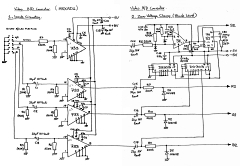 |
|
Controller/ Memory board, HRX-CM |
| A copy of the layout for the
Controller / Memory board - the layout shows 256KB of RAM using 4164 memory -
a
Fairchild TDC1016, video speed, 10-bit D/A
converter |
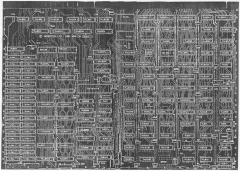 |
| Hand written parts list for the
Controller / Memory board |
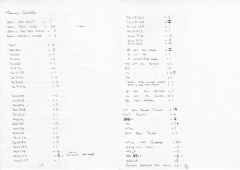 |
|
Double Memory board, HRX-MM |
| A copy of the layout for the
Double Memory board - the layout shows 2
banks of 256KB of RAM using 4164 memory - a
pair of
Fairchild TDC1016s, video speed, 10-bit
D/A converters |
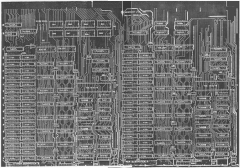 |
| Hand written parts list for the
Double Memory board Also includes the parts list
for a "Frame Grabber" board, which Tony advises is
just an other name for the A/D converter board, and
in fact, has the same parts listed as on the A/D
board. |
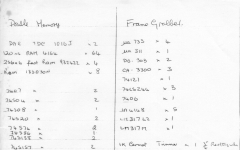 |
|